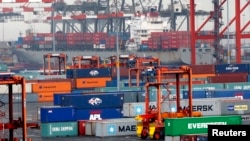The U.S. trade deficit in January hit the highest level in nearly five years.
Tuesday's report from the Commerce Department says the gap between what Americans sell to foreigners and what U.S. customers buy from overseas grew by 9.6 percent for the month to $48.5 billion.
U.S. exports rose six-tenths of a percent, as American companies sold more cars overseas, but U.S. commercial aircraft sales faltered. Export gains were overwhelmed by a surge in imported cell phones and autos, along with rising costs for oil imports.
The head of the White House National Trade Council, Peter Navarro wrote in the Wall Street Journal recently that the trade deficit hurts economic growth and could be a threat to national security.
In a note to journalists, analysts at Wells Fargo Securities say growing exports and imports are also a sign of improving economies in the United States and key trading partners. They blame some of the trade gap on the strength of the U.S. dollar, which means American-made products are more expensive, and harder to sell on global markets.
Other concerns came to light in a survey of hundreds of economists across the nation by the National Association for Business Economics. Many of these experts said expected increases in government spending could increase the deficit.
In a VOA interview, survey committee chair Richard DeKaser said members have concerns about efforts to limit immigration to the United States, and would support allowing more arrivals for highly-skilled migrants.
Housing market
A separate report from a private company says U.S. home prices jumped a strong 6.9 percent during the past year. Tuesday's report from CoreLogic also forecasts a 4.8 percent price gain over the next year, which is well above the expected rate of inflation. The authors say prices are rising because of economic recovery, limited supply of homes for sale, and continued low mortgage interest rates.
Economists have been watching the housing market with particular care since severe problems in this sector contributed to the Great Recession.










